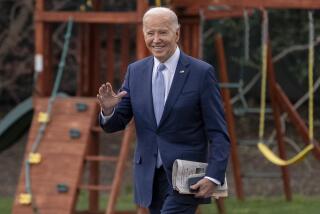Trump’s ‘hard power’ budget makes sweeping cuts to EPA and State Department, boosts defense spending

The Trump administration proposes dramatic cuts to the State, health and education departments while ramping up defense spending and $4 billion for construction of a border wall.
President Trump released a spending plan Thursday that would slash programs across government with a machete to pay for sharp increases in the military, veterans’ health and the construction of a wall along the southwest border.
On the chopping block: billions of dollars in research aimed at fighting diseases and climate change; job training programs; grants to local communities that pay for public transit and housing, heating oil for the poor; diplomatic efforts across the globe; and libraries.
Proposed for elimination: at least 19 independent agencies including the Corporation for Public Broadcasting, the National Endowment for the Arts and the National Endowment for the Humanities.
Trump argued that many of the programs he wants to slash are ineffective, outdated or duplicative. Beyond that, he says the budget is sending a message to reorder $1.1 trillion in the federal government’s discretionary spending around his “America First” agenda, putting defense and border security at the center while curtailing other government functions.
“We can’t spend money on programs just because they sound good,” said Mick Mulvaney, director of the Office of Management and Budget and a conservative former congressman from South Carolina.
In addition to proposing cuts across the spectrum, Trump would increase funding for school choice, counter-terrorism and the hiring of more border agents and immigration judges and prosecutors. But the biggest increase, by far, would go to the military in the form of an additional $54 billion in annual spending.
The budget, which lacks many details Trump and his agency leaders will add in the coming months, will not become law in its current form.
Nearly every plank will face significant obstacles from both parties in Congress, which has been unable in recent years to reach agreement on even the most basic spending measures. But it lays out the president’s vision more specifically than any speech or statement Trump delivered during his 17 months on the campaign trail or the four months since he won election.
Aides said the proposal was adapted directly from the president’s own campaign rhetoric, starting with his pledge to restore the nation’s military. The proposed boost in Pentagon funding itself is greater than the overall budgets of 11 other Cabinet departments. But some promises, like curing diseases, will be harder to fulfill with a proposed cut of $5.8 billion to the National Institutes of Health.
Many of the costs taken out of the budget would be shifted to states and localities — which would lose grants they depend on to build bus lines, support teacher salaries or provide clean water to rural communities. And although the budget includes no guidance on taxes, it proposes fee hikes on airline tickets, federal bankruptcy filings and medical device manufacturers.
“The Trump administration says, ‘We are going to leave it to state and local governments who are better positioned to deal with these issues,’ but we are only better positioned if we have that partnership,” said Phil Serna, a supervisor in Sacramento County, where a comprehensive plan to tackle the homeless problem is jeopardized by the White House budget.
The cost of backfilling all the proposed federal cuts would crush the county’s budget, said Serna. It could not afford to bankroll bedrock local environmental programs and would have to abandon an urban street car program getting underway and plans to extend mass transit to the region’s new airport.
The EPA suffers most under the spending plan, with a 31.4% reduction in its budget. The departments of Agriculture and Labor each face a 20% funding cut, and five more Cabinet-level departments see cuts in the teens.
A memo from Democrats on the Senate Budget Committee, led by Sen. Bernie Sanders (I-Vt.), warned that Trump’s plan “would cause even more economic pain and suffering to the elderly, the children, the sick and the most vulnerable.”
The plan released Thursday is only the first step in a months-long process leading up to the beginning of the fiscal year on Oct. 1. A more detailed, line-by-line budget document that would also address mandatory spending programs will come in May. And along the way will be heated debates with lawmakers and other stakeholders about what programs to cut and which to preserve or beef up.
The Oct. 1 deadline is particularly important this year because spending levels from a past budget accord are set to expire. Without a new deal, automatic cuts would take effect that many in Congress want to avoid.
Although Trump’s budget reflects long-held ambitions of conservatives eager to shrink the size and scope of the federal government, it leaves unaddressed spending on entitlement programs such as Medicare, Medicaid and Social Security that are among the biggest drivers of federal spending.
The latter point is where Trump, who pledged to protect and strengthen those entrenched safety net programs, differs most dramatically with a fellow Republican who has long pushed for a new approach: House Speaker Paul D. Ryan (R-Wis.).
“Do I think we can cut spending and get waste out of government? Absolutely. Where and how, and what numbers, that’s something we’ll be figuring out as time goes on,” Ryan told reporters.
The budget could test the coalition of traditional fiscal conservatives and the nationalists that Trump has attracted, both in his campaign and within the ranks of his senior staff.
Some steep cuts fall on programs designed to revive poorer, rural communities where Trump benefited from greater-than-expected turnout last fall. He proposed eliminating the Appalachian Regional Commission, which provides grants for education, broadband and other programs in rural communities, and a program that provides millions of poor and elderly with assistance to heat their houses in the winter.
Though the president had promised in his campaign to help revive inner cities, the Department of Housing and Urban Development will see major spending cuts. So too will the Department of Transportation, despite Trump’s pledge to fix the nation’s crumbling infrastructure.
AFL-CIO President Richard Trumka said the plan would be devastating to workers in states like Ohio, Pennsylvania, Michigan and Wisconsin — states that powered Trump to an upset election victory — by slashing infrastructure and worker-training programs.
Mulvaney explained that the spending plan will still work to address Trump’s objectives in those areas, but that they can only be accomplished in part by eliminating programs that have failed to achieve those goals.
The budget is not designed to reduce the deficit at all, just shift money around, so the overall level of federal debt would continue to rise. It hit $19.9 trillion Thursday, breaching the limit set by Congress and forcing the Treasury Department to start using accounting maneuvers to avoid a federal default.
The Trump administration’s plans for sweeping cuts in foreign aid — Mulvaney bluntly called it a “hard power,” not “soft power budget” — may be dead on arrival with GOP lawmakers who stress the need for a more balanced approach emphasizing both military strength and a commitment to diplomacy.
The chairmen of the House and Senate Armed Services Committees said that Trump’s Pentagon funding proposal falls short of what’s needed, even with the major increase.
Secretary of State Rex Tillerson, traveling in Asia, said he understood the challenge he now faces in implementing the cuts in his department.
“We are going to construct a way forward that allows us to be much more effective, much more efficient and be able to do a lot with fewer dollars,” Tillerson said in rare public remarks.
The budget calls for $2.6 billion in spending on the president’s proposed border wall and $314 million for new Border Patrol agents and Immigration and Customs Enforcement personnel. The administration also asked Congress to pass $3 billion in funding for additional border protection measures this year. The administration will use the border funds on pilot projects that will help determine the safest and most cost-efficient methods for securing areas along the U.S.-Mexico border.
Trump’s plan seeks to dismantle a major second-term priority of President Obama by cutting off funding for the Clean Power Plan, which was a core component of U.S. commitments as part of the landmark Paris agreement to mitigate the impacts of climate change.
The budget does not assume the repeal of the Affordable Care Act in favor of a new healthcare system proposed by the GOP. But it includes a nearly 18% cut in funding at the Health and Human Services Department.
The administration also wants to spend $1.4 billion to expand vouchers, including for private schools, and would pay for it with deep cuts to federal aid to public schools.
Voucher programs, a favorite cause of Education Secretary Betsy DeVos, provide funds to families that they can use to help pay for tuition at private or religious schools.
The $1.4 billion in the budget would be the down payment on a program that would be “ramping up to an annual total of $20 billion,” the budget says.
Times staff writers Evan Halper, Lisa Mascaro, W.J. Hennigan, Noam N. Levey, David Lauter and Tracy Wilkinson contributed to this report.
Twitter: @noahbierman
Twitter: @mikememoli
ALSO
Here’s why the GOP is struggling to come up with a new healthcare plan: That wasn’t the goal
Trump wants $54 billion more for defense. The military isn’t sure what that means
UPDATES:
2:40 p.m.: This story was updated with reaction from a local official in Sacramento County.
1:10 p.m.: This story was updated throughout with details on the budget and reaction from lawmakers.
7:30 a.m.: This story was updated with details on proposals to cut all funding for certain agencies.
6:50 a.m.: This story was updated with details on proposed budget cuts.
March 16, 5:45 a.m.: This story was updated with the release of the budget.
This story was originally published March 15 at 9:05 p.m.
More to Read
Start your day right
Sign up for Essential California for news, features and recommendations from the L.A. Times and beyond in your inbox six days a week.
You may occasionally receive promotional content from the Los Angeles Times.








